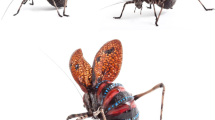Abstract
Death feigning is an anti-predator behavior that is found in many animal taxa. Death feigning is thought to inhibit further attacks by predators and reduce the perceived need of the predator to subdue prey further. One of the hypotheses regarding the function of mimicry in death is the “selfish-prey hypothesis” where the prey sacrifices of other individuals of the same species. That is, the optimal intensity of death feigning may depend on the prey population density. Reported variations in the intensity of death feigning among wild populations may arise from differences in the prey population density. Here, I investigated the relationship between the intensity of death feigning and population density in the red flour beetle, Tribolium castaneum. Beetles were randomly collected from six wild populations and the prey population density was estimated. I also observed death-feigning behavior when the beetles were stimulated by artificial stimuli. The results showed that the duration of death feigning differed significantly among wild populations. However, this difference was not associated with the population density of T. castaneum. Although body mass differed within the wild population, there were no significant effects of body mass on death feigning. Therefore, the effects of prey population density on death-feigning behavior in T. castaneum are small.



Similar content being viewed by others
References
Bilde T, Tuni C, Elsayed R, Pekár S, Toft S (2006) Death feigning in the face of sexual cannibalism. Biol Lett 2:23–25
Creighton JC (2005) Population density, body size, and phenotypic plasticity of brood size in a burying beetle. Behav Ecol 16:1031–1036
Damuth J (1981) Population density and body size in mammals. Nature 290:699–700
Edmunds M (1974) Defence in animals: a survey of antipredator defences. Longman, Harlow, UK
Fedina TY, Lewis SM (2008) An integrative view of sexual selection in Tribolium flour beetles. Biol Rev 83(2):151–171. https://doi.org/10.1111/j.1469-185X.2008.00037.x
Foster WA, Treherne JE (1981) Evidence for the dilution effect in the selfish herd from fish predation on a marine insect. Nature 293:466–467
Gish M, Dafni A, Inbar M (2010) Mammalian herbivore breath alerts aphids to flee host plant. Current Biol 20:628–629
Honma A, Oku S, Nishida T (2006) Adaptive significance of death feigning posture as a specialized inducible defence against gape-limited predators. Proc R Soc B Biol Sci 273:1631–1636
Hozumi N, Miyatake T (2005) Body-size dependent difference in death-feigning behavior of adult Callosobruchus chinensis. J Insect Behav 18:557–566
Humphreys RK, Ruxton GD (2018) A review of thanatosis (death feigning) as an anti-predator behaviour. Behav Ecol Sociobiol 72:22. https://doi.org/10.1007/s00265-017-2436-8
Khelifa R (2017) Faking death to avoid male coercion: extreme sexual conflict resolution in a dragonfly. Ecology 98:1724–1726
Kiyotake H, Matsumoto H, Nakayama S, Sakai M, Miyatake T, Ryuda M, Hayakawa Y (2014) Gain of long tonic immobility behavioral trait causes the red flour beetle to reduce anti-stress capacity. J Insect Physiol 60:92–97
Konishi K, Matsumura K, Sakuno W, Miyatake T (2020) Death feigning as an adaptive anti-predator behaviour: further evidence for its evolution from artificial selection and natural populations. J Evol Biol 33:1120–1128
Kuriwada T, Kumano N, Shiromoto K, Haraguchi D (2009) Copulation reduces the duration of death-feigning behaviour in the sweetpotato weevil, Cylas formicarius. Anim Behav 78:1145–1151
Kuriwada T, Kumano N, Shiromoto K, Haraguchi D (2011) Age-dependent investment in death-feigning behaviour in the sweetpotato weevil Cylas formicarius. Physiol Entomol 36:149–154
Matsumura K, Miyatake T (2020) Is there a genetic correlation between movement and immobility in field populations of a beetle? bioRxiv. https://doi.org/10.1101/2020.08.10.245431
Miyatake T, Katayama K, Takeda Y, Nakashima A, Sugita A, Mizumoto M (2004) Is death-feigning adaptive? Heritable variation in fitness difference of death-feigning behaviour. Proc R Soc B Biol Sci 271:2293–2296
Miyatake T, Nakayama S, Nishi Y, Nakajima S (2009) Tonically immobilized selfish prey can survive by sacrificing others. Proc R Soc B Biol Sci 276:2763–2767
Nakayama S, Miyatake T (2010a) Genetic trade-off between abilities to avoid attack and to mate: a cost of tonic immobility. Biol Lett 6:18–20
Nakayama S, Miyatake T (2010b) A behavioral syndrome in the adzuki bean beetle: genetic correlation among death feigning, activity, and mating behavior. Ethology 116:108–112
Ohno T, Miyatake T (2007) Drop or fly? Negative genetic correlation between death-feigning intensity and flying ability as alternative anti-predator strategies. Proc R Soc B Biol Sci 274:555–560
R Core Team (2017) R: a language and environment for statistical computing. R Foundation for Statistical Computing, Vienna
Turner GF, Pitcher TJ (1986) Attack abatement: a model for group protection by combined avoidance and dilution. Am Nat 128:228–240
Acknowledgements
This work was supported by Grant-in-Aid for Japan Society for the Promotion of Science (JSPS) Fellows 20J00383 to K.M.
Author information
Authors and Affiliations
Corresponding author
Additional information
Publisher's Note
Springer Nature remains neutral with regard to jurisdictional claims in published maps and institutional affiliations.
Supplementary Information
Below is the link to the electronic supplementary material.
About this article
Cite this article
Matsumura, K. Relationship between death-feigning behavior and population density in a beetle. J Ethol 39, 363–367 (2021). https://doi.org/10.1007/s10164-021-00713-2
Received:
Accepted:
Published:
Issue Date:
DOI: https://doi.org/10.1007/s10164-021-00713-2




